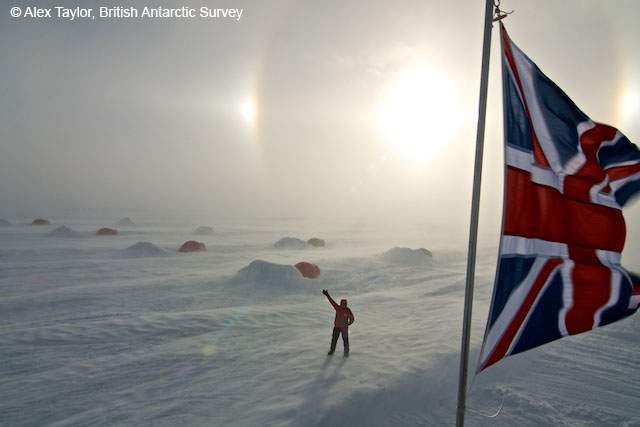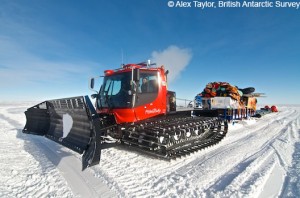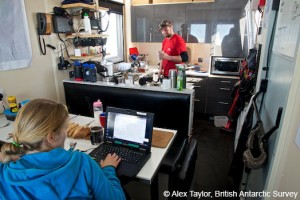Emma Smith, a geophysical glaciologist, has filed this update from Pine Island Glacier:
After nearly two weeks at the first field site (iSTAR 20) all twelve of the team were finally present, the first of the ice cores was drilled and it was time to set off on our first traverse to the next site. During this field season we will be visiting twenty-two different sites on Pine Island Glacier, collecting a huge variety of science data at each one. To move between them we will be using two Pisten Bully snow bulldozers to pull two tractor trains containing science cargo, a living caboose, four ski-doos, tents, fuel and food. The sixty metre long trains are quite a sight to behold against the flat white expanse of Pine Island Glacier, containing everything we need for living and working in this hostile environment for the next 2 months. While the science is the main aim of the iSTAR traverse the logistics involved in moving an entire field camp every few days is just as impressive and important. At a field site the activities are dictated by the scientists and their projects but moving between sites is definitely the domain of the two mechanics, Tim and Mark, and the traverse leader James.
The morning of the move came and we were all up early to put down tents and pack up our kit. We then piled into our 6 by 2.5 meter caboose for the journey (a converted shipping container with a kitchen and seating space). I was pretty excited about setting off on our first move, a seventy km leg that would take about 6 hours. The excitement rapidly turned into mild nausea as we started to sway our way across the continent in a motion much like a small boat on a rocky sea. After a while we all got used to the movement and made the most of some time to chat, read, watch movies and listen to music. After a few hours of bumping our way across the sastrugi strewn surface at a swift eleven km/h The inevitable boredom set in and singing across the VHF started. Tim started off from the Pisten Bully cab (“Polar 1”) with a rendition of “I know a song that gets on your nerves…” which repeats ad nauseum, rapidly followed by “Don’t Stop Believing” – it seems that the Glee soundtrack has finally penetrated the most uninhabited continent on Earth, I’m not sure how I feel about this!
We arrived at our next site for a brief one night stop to dismantle a GPS station that had been collecting data on ice surface movement for the last year. It was to be a busy and chilly night of work for one member of our team, Sebastian Rosier, with temperatures averaging between -20°C and -30°C . Then the next morning we were back in the caboose for another leg of the traverse across the bumpy sastrugi, this time just twenty km long.
After a few more hours we arrived and clambered out to have a look at our new home. It looked suspiciously like the last one – flat and white. I suspect this is something we are all going to have to get used to over the coming weeks. This area of Antarctica is far away from any significant mountain ranges and we won’t be getting near enough to the coast to see anything. However, there is something beautiful and poignant about being the only presence in such a desolate environment. In many ways this is the reason I wanted to come to Antarctica in the first place.


